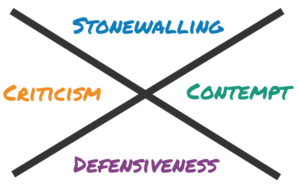We know from Team Toxins and Team Conflict, that toxins are normal. So we can’t just “get rid of them.” In fact, pretending there are never toxins in a team could be viewed as a form of stonewalling. There are a number of ways to resolve conflict by working with team toxins. These not “iron-clad plans” or best practices, they are approaches to resolving conflict that ideally start before major conflict has emerged.
The four team toxins are criticism, contempt, defensiveness, and stonewalling.
Below I list a number of ways to work with team toxins. These are ideas that make or break our teams and relationships. I believe they make the difference between being engaged and checking-out. Many of these ideas are concepts that should be explored and

examined, they are not just “steps” that you can do and check-off a list. Some are simpler than others, but all require a level of commitment and effort to dig into and learn from and about.
Ways to resolve conflict by working with team toxins:
- Educate the team — a team that understands what toxins are, that they are normal, and that they have value to the people exhibiting them — is a team that is able to continue to improve and thrive. Read Team Toxins and Team Conflict for a foundational understanding
 (and you can also find other articles via Google). Realize that in a situation that is very toxic, you may need to take this step quite lightly. Remember that toxins are providing some level of value — so attempting to just “educate them away” may cause the opposite or an unexpected results.
(and you can also find other articles via Google). Realize that in a situation that is very toxic, you may need to take this step quite lightly. Remember that toxins are providing some level of value — so attempting to just “educate them away” may cause the opposite or an unexpected results. - Create a Conflict Protocol to deal with toxins — how will each individual deal with them when they come up? What can you count on from each other to deal with them? Are team members capable to naming toxins as they come up?
- Check-in with and update (as needed) your Team Alliance each time toxins occur. Continuing to expand your Team Alliance is an important to learning, growing, and improving the teams relationship — and capabilities to deal with toxins.
- Hire a coach to help the team build an Team Alliance, Conflict Protocol, and educate the team. This may not be needed in every situation, but certainly if you are feeling like you are not sure how to address the issues or if you believe you may be contributing to the toxic situation, find a coach to work with. Often, an external person can help the team breakthrough to the next level because they are not involved in the day to day (and have training and experience in that type of work).
- Bring in a Team Toxins Workshop. This workshop allows everyone on the team or group to experience toxins, what they are like, identify their preferred toxin, and to explore antidotes for each toxin. Working with team toxins provides the opportunity to experience toxins (interactively) in a way that allows you to explore and learn sets the stage for the team to thrive. [If you are interested in a Team Toxins Workshop for your team, let us know].
- Name the toxin when it occurs. This requires a strong Team Alliance, but it is where teams should be moving if they want to truly be great!
- Use true curiosity (not questioning). Can everyone bring true curiosity to team interactions? Can they ask each other questions without judgment?
- Switch to a soft start-up instead of a harsh start-up. This can be challenging if you (or others on the team) have put off bringing up a big issue until it boils over. This is typically worth exploring as well. Why is everyone waiting to bring things up?
- Work on the premise that all the voices of the system (or team) have value. This alone can be a challenging place to come from when working on a team. What will it be like if even the most unpopular voice is valuable?
- Seek mediation or coaching help on an issue or situation to stabilize it if it is too hot. You may engage someone at your organization or externally, but bring in help if you feel like there is value in it. With contempt specifically, professional development is recommended. Contempt is very damaging not just to the person who is receiving it but also the giver! This can really turn into a downward spiral. When you have a really hot situation, there are other steps that should be taken BEFORE starting to work with toxins!
- Learn more and consider training to learn about professional coaching. I first learned about toxins via CRR Global. They offer training and certification that focuses on many of the ideas, tools, and most importantly, the mindset you need to work with these challenges. If you find you have a passion for this type of work, I’d highly recommend reviewing what they offer. If you have questions about them for me, let me know. I’d be glad to talk with you.
- There are many more ideas, but these are a start!
Moving Forward
As I noted, most of these ideas for working with team toxins are not simple steps to be taken, but areas to focus on over time. These ideas can be used for you individually to begin to change or improve your style or to work with a team on these ideas as a group. There are ideas that can be tapped into as questions for a team to use in a retrospective. Finally, there are ideas that may require seeking some outside help if things are simply “too hot.” Start with the ideas you can work on individually, ask yourself what you can do differently.
What steps can you take to move forward?










